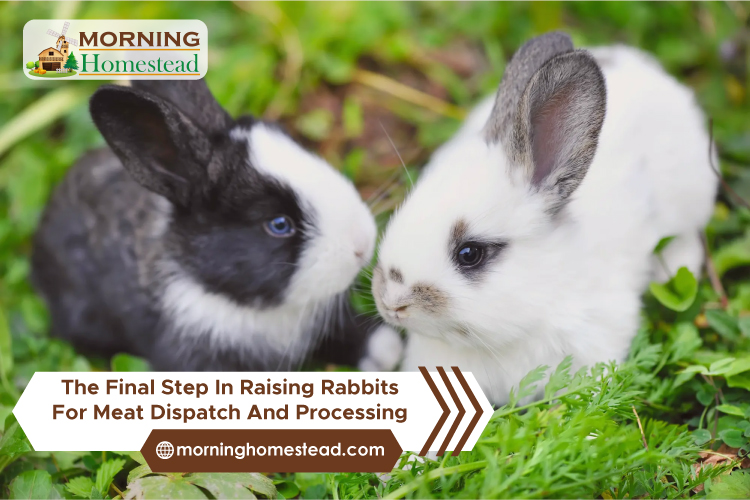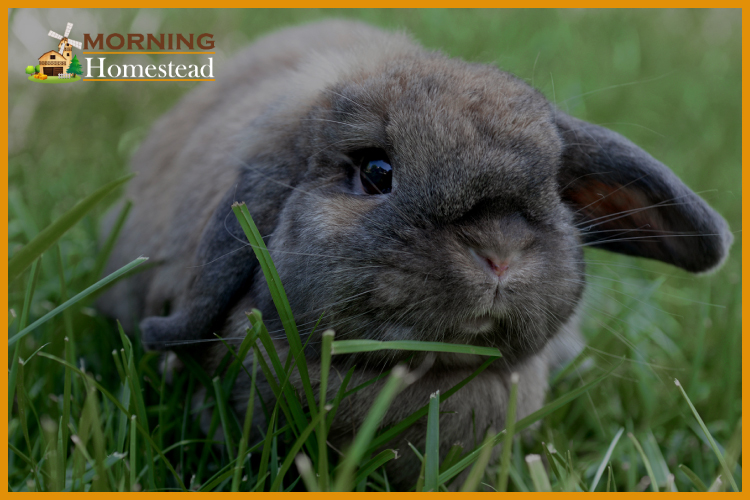Last Updated on May 9, 2023 by morninghomestead
The final step for a homesteading rabbit farmer is the hardest but, in many ways, the most important. Dispatch and processing.
As we discussed in the previous guide, The Homesteaders Guide to Rabbit Farming, the number one rule for dispatch is to do it quickly and humanely. The first time you go through a dispatch process it can be overwhelming and daunting. Dispatch is never a job you want to screw up. If you can, reach out to an experienced rabbit farmer. Oftentimes they will be happy to let you volunteer to help with one of their dispatch and butchering days. Or you may be able to bring your rabbits and learn the process with your own while having their hands-on help for guidance.
Also, not every rabbit farmer feels comfortable conducting the dispatch and butchering process. That’s okay. Find people that you can pay to do the job for you if that is the case. Or some people partner with other rabbit farming friends in a ‘you do mine, I’ll do yours’ exchange which can be easier. The main thing is knowing it needs to be done, properly preparing to do it right, and following through when the time comes.
At the end of the day, it is never easy taking an animal’s life. You should always approach it with the thought of honoring and respecting the animal for its sacrifice. Yet, there is a deep satisfaction in knowing you raised them well, treated and dispatched them humanely, and have a freezer full of meat to feed your family with from the endeavor.
When you buy meat at the grocery store you have no control over the conditions the animal was raised in, or dispatched. When you do it yourself, you can control all the variables and can feel good about the final product because you controlled it from the beginning until the end.
Setting Up a Location to Butcher Your Rabbits
When dispatch time draws near — typically between 10 and 14 weeks is the prime time for processing for most meat rabbit breeds — think first about where you will set up your processing.
The easiest place for clean-up is outside. However, if your processing date is coming up during the winter and spring months, you might have weather that is too cold or wet to allow for comfortable processing.
One option is to set up inside a greenhouse, assuming have a greenhouse that has nothing growing in it for the winter. This provides you with protection from the elements and that can make all the difference when it comes time to process!
You can also process inside a garage, shed, barn or someplace similar. Just be prepared to clean well. If you have a concrete floor and can spray it out, it’s an easy job. Or, you can lay down a plastic tarp and work on top of that and just remove the tarp when the job’s finished.
If you are processing in nice weather outside, one thing to keep in mind is neighbors. Even though it is perfectly legal to process your rabbits for meat, some people may not understand what you are doing. This can create problems with neighbors. In more rural areas of the country, this typically isn’t an issue. But if you live in a suburban area it can cause some tension that is best avoided from the beginning.
You will also need to decide how you want to hang your rabbit for processing. If you decide to use the HopperPopper (more about it below) you will need a wall or tree that it can be installed on. Some people prefer to hang their rabbits after dispatch from a tree or overhead bar with a slip-knot on each leg, so they can access the rabbit on all sides. Either way works but what infrastructure you already have might drive your set-up.
Tools for Rabbit Butchering
You don’t need a lot of tools for butchering rabbits, but what you do need should be good quality and, in the case of knives, sharp! A high-quality knife, well-sharpened will make the job quick and easy.
List of Tools
| Victorinox Black Boning Knife |
|---|
| Victorinox Pro Chef’s Knife |
| Victorinox Classic Steak Knife |
| Gonic Professional Bypass Pruning Shears |
| Rubbermaid 10 Gallon Bucket |
| Cosco Folding Table |
| 3KM Garden Hose |
| Tuff-Stuff 40 Gallon Oval Tank |
| Vinyl Gloves |
Decide How You Will Dispatch
There are many different methods used for dispatch. The following are three that are the most common and all very humane if done correctly.
The Broom Stick Method
The Broom Stick Method uses cervical dislocation to quickly dispatch of a rabbit. It has the advantage of being very economical (almost anyone has a broomstick!) and also easy to set-up if another method is not available. This can be handy if you have a rabbit that is suffering that needs to be dispatched quickly because of an injury or another issue.
Step 1 – Place the rabbit on the ground in front of a treat of something they like to eat.
Step 2 – Using a broomstick, or another straight tool, place it over the rabbit’s neck, directly behind its head.
Step 3 -Step on one side of the broomstick
Step 4 – Reach down and gather the rabbit’s hind legs in your hands. Then, step on the other side of the broomstick and simultaneously pull the rabbit’s hind feet quickly and firmly upward toward yourself. You should feel the neck bones stretch and dislocate, at that point the rabbit is dead.
Pros – Easy to set up, inexpensive
Cons – If you have a very active or scared rabbit, it can be hard to keep them from running off in the time between setting them on the ground, putting the pole over the neck, and then performing the dislocation. It can be awkward to step on two sides of a pole while bending over for. You do want to do it very quickly, because if you step on the pole on both sides without pulling upwards at the same time that results in strangling the rabbit and causing suffering.
Some people do find the broomstick method very easy, it just depends on your capabilities.
The Hopper Popper
The Hopper Popper also uses cervical dislocation but uses a pre-installed tool. The most commonly known version of this is a branded product you can purchase. It’s simply a stainless-steel bar welded onto a solid frame to install onto a wall. Some people do weld and create their own, it just depends on how handy you are at that sort of thing!
The Hopper Popper method involves installing the bar on an upright surface at an angle so it creates out at a ‘V.” Some people install it on a tree. Others use a barn wall. It must be properly and securely installed to work correctly.
- Step One – Holding the rabbit in your armpit, you quickly scruff the rabbit and holding the rabbit’s head away from you, slide the rabbit at the point of its neck into the widest part of the ‘V’ and as far into the narrow part as possible.
- Step Two – At this point, the rabbit will be hanging by its neck when you let go, so you quickly grab both hind legs and with a solid tug, leaning back with the weight of your body, stretch the rabbit at a 45-degree angle. This will dislocate its cervix.
Pros – Typically very easy process to use. It contains the rabbit better if it is scared or wants to flee.
Cons – You have to have a bit of strength, or body weight, to properly pull back and get the quick dislocation. If you purchase the Hopper Popper there is an expense involved.
You can order a Hopper Popper at their website HERE.
Pellet Gun Dispatch
Some people prefer to use a pellet gun, or air rifle, to dispatch their rabbits. You can also use a small-caliber handgun, but typically not if you live in city limits where shooting firearms is not allowed.
- Step One – Place the rabbit on the ground, in front of something they want to eat.
- Step Two -Place the pellet gun right against the base of the skull below the ears.
- Step Three – Pump several times. The rabbit should be instantly dead.
Pros – Quick death.
Cons – Expense of the gun purchase. Again, can be hard to contain an animal that is squirming and hold onto and pump the rifle at the same time. It can take practice.
| Gamo Varmint Air Rifle |
|---|
A Note on Squealing and Death Throes
If you handle your rabbits regularly, typically they will not utter a sound during the dispatch steps. Every once in a while, however, you will get a ‘squealer’ and it can be disturbing! Some rabbits are just more sensitive and will do it even if you are just handling them. There is nothing to be done but move through the process quickly.
No matter how you dispatch, you will observe death throes. This is a normal part of the process. If the dispatch was done quickly, the rabbit is not suffering. Death ‘throes’ are a normal part of the death process as the nerve endings react.
On to Butchering Your Rabbit
With dispatch, the hardest part, is complete it is time to move on to butchering. You should always wear thin, disposable gloves while butchering, though lots of people do not. But, rabbits can carry diseases and bacteria internally that can pass on to humans. One of those most common is an abscess or ‘pus’ pocket that can be caused either by Pasteurella multimedia
and Staphylococcus aureus bacteria. The staph bacteria are potentially problematic for humans especially if there is a cut or wound that it can invade.
Part One – Removing the Hide
Step One
Hang the rabbit. You can do so with two thin, strong pieces of rope tied in a loop just past the first joint on each of the rabbit’s hind legs and attached to an overhead pole or tree branch. Or you can purchase hanging hooks that allow you to slip the feet in. Some prefer to be able to access the rabbit from all sides if the butchering process. If that is the case, you will want to set up a situation where you can tie it by its hind legs to hang.
Step Two
Using your chef’s knife, hold the head firmly and slice off just past the ears. It can take a little bit of strength to break through the neck cartilage.
Step Three
Using your hand-held pruners, clip off the front paws right at the first joint.
Step Four
Starting with one hind leg at the joint (hock), use your paring knife and carefully poke through the hide and first membrane layer of skin. It is easiest if you can sort of pull the skin up and out to poke in the first cut. You want to avoid cutting too deep into the tendon of the leg. Always cut with the knife outward (so you don’t cut too deep) and carefully work around the leg in the circle. Then you should be able to grasp the loosened skin and pull it further down the leg to the hip joint. Do the same thing with the other leg.
Step Five
Now, starting at the base of the tail where the back meets the tail, cut through to the anus. Be very careful to not cut too deep and it is always best practice once you have the initial incision, to angle your knife in under the skin membrane and keep cutting outwards. Keep cutting along the V the two legs make, on either side, until you reach the skin you had already loosened on either leg. When you are done, you want to have a clean open slice from the inside of each leg across the rabbit’s bottom.
Step Six
At this point, you should be able to grab the hide with both hands and start pulling and peel the hide and skin off the hide and first layer of skin ‘like a banana.’ It should pull down and slip past the neck (remember the head has already been removed). With rabbits at the ideal age (between 10 and 14 weeks), the hide typically slips off quite easily. Older rabbits have more connective tissue and can require a lot more tugging.
Step Seven
You should end up with what looks like a ‘tube’ with rabbit fur on the inside and skin on the outside. Just roll that up and put it in a garbage bag. You can freeze the hide and take it out to tan at a later time.
Part Two – Eviscerating
Now that the rabbit’s hide is removed, you can eviscerate the intestines and internal organs.
Step One
Starting at the base of the anus, make a very careful cut with the point of the knife. Continue cutting through the muscle over the belly working downwards.
Step Two
Usually, once you get a few inches down you will expose the bladder. It looks like a small yellow balloon attached to a yellow tube. Pinching the tube off, cut above where you have pinched and remove the bladder and toss it into your offal bucket. If you accidentally do nick the bladder and get urine on your carcass, it is okay, you will spray it off later.
Step Three
Keep cutting down carefully to the point of the rib cage.
Step Four
At this point, all the intestines and internal organs should be exposed and are typically starting to fall out of their own accord. Starting now inside the cavity, start at the top by the anus using your hand to carefully remove the intestines and internal organs. Sometimes you will need your knife to cut through connective tissue or if there is a lot of fat.
Step Four
You can save the liver if you like to eat. Many people consider rabbit liver a delicacy. If you decide to do that, make sure to remove the bile duct. The bile duct is a small, dark green sack attached on one side. Grasp that firmly and pinching it off, quickly pull it off the liver. If you do rupture the bile duct, that will ruin the meat, so you don’t want to let it get on the liver (or the rest of your rabbit carcass!).
Part Three – Finishing Up
Now you are done with the evisceration process and just need to clean up.
Step One
Turn your hose on and rinse the carcass well, inside and out.
Step Two
Put the carcass into a tub or cooler of ice water, leave there for 24 hours.
Step Three
Clean up and bury or burn the offal. (Always remember offal will attract unwanted predators to your property, so make sure to dispose of it well!).
Step Four
After 24 hours, remove carcasses from water, pat dry, and bag however you plan to (some people use 4-gallon sealable freezer bags), and freeze or refrigerate.
And you’re done!
Butchering Rabbits is a Great Way to Check the Health of Your Herd
On a final note, when you are butchering your rabbit you should always use the opportunity to inspect the internal systems of your animals for any possible health conditions. The liver, in particular, is a good clue that something could be wrong. It should look dark red and firm. If it has little white spots in it, that is a sign of coccidiosis, a type of internal parasite that can cause havoc in your rabbitry (but can be treated if you know it’s there!). Sometimes there will be other indications of health issues – like a rabbit with lots of internal fat is a sign you are overfeeding!
After you have butchered a few you will learn what is healthy and what’s not.If you butcher an animal that appears to have issues, it is always best to NOT eat the meat unless you know for sure what the problem is. The purpose of growing rabbits for yourself is healthy meat, so if the meat doesn’t appear to be healthy – don’t eat it! Take lots of photos and go online to rabbit forums and you will likely find somebody that can diagnose what is wrong with your rabbit from the pictures.
Now the final step is to cook your rabbit meat using 100s of potential rabbit recipes. Get ready to enjoy some “Hasenpfeffer” (German for ‘rabbit stew’) and happy Homesteader Rabbit Raising!




![Best Rabbit Bedding For Odor Control: Reviews And Guide [2023] Rabbit-Bedding-For-Odor-Control](https://morninghomestead.com/wp-content/uploads/2020/07/Rabbit-Bedding-For-Odor-Control-150x150.jpg)
